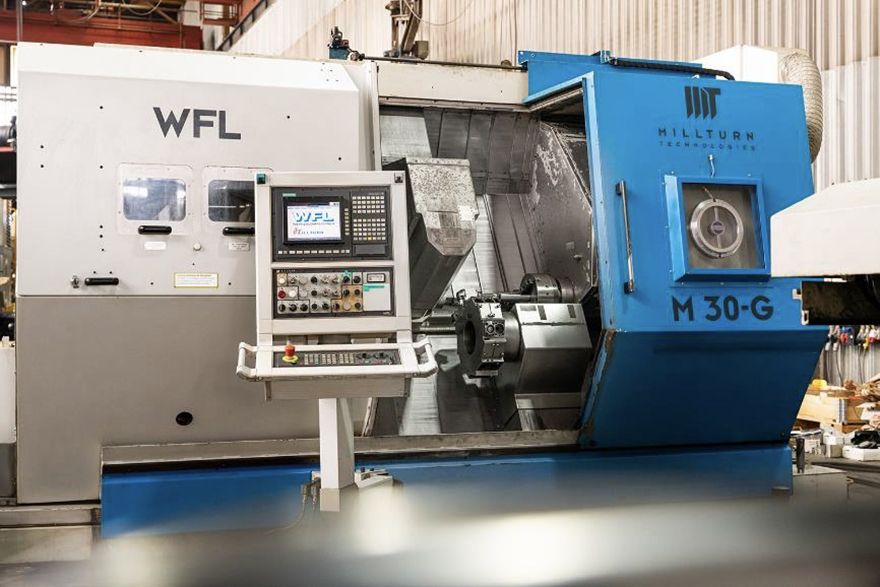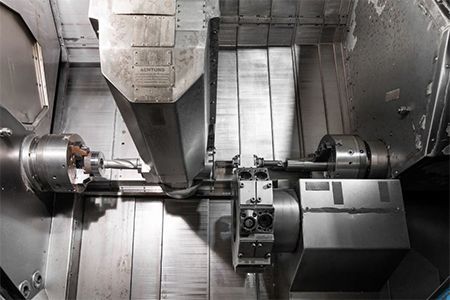 A WFL machine still hard at work after 25 years
A WFL machine still hard at work after 25 yearsThe M30 Millturn is one of the most popular and successful WFL machines in the extensive Millturn range offerd by Austria-based
WFL Millturn Technologies and is available in the UK from Leicestershire-based
Kyal Machine Tools.
The classic Millturn machining centre ushered in a completely new era when it was first launched more than 25 years ago. It was in fact the first WFL Millturn with an individual tool carrier for turning, drilling and milling with a B-axis and many of these older M30 machines remain in use today — in fact, when looked after, the oldest member of the Millturn family can still deliver a top performance. Ultimately, supreme quality and lasting accuracy are among the virtues of all WFL machines.
Although the current design has very little in common with the original version, the basic structure with the stable 60deg slant bed is still there. Particularly noteworthy features include the powerful headstock with 37kW main drive and two-speed gearbox as well as external C-axis. While the design dates back to the earlier Voest-Alpine WNC slant bed machines, it is still used in the latest Millturn models of the M35, M40 and M50 series with modernised drive motors, although water-cooled direct drives are available as alternatives nowadays.
The first machines in the M30 series still featured a 24-space magazine with ATC permanently mounted on the milling unit. Back then, it was a reliable and practical solution. But it was soon replaced by an external magazine over the left-hand headstock that was much easier to operate and had an initial capacity of 48 tool stations, which was a lot back then. This made setting up the tools parallel to machining time possible for the first time.
The capacity was then expanded to up to 96 tool stations. Modular systems such as HSK50, Capto C4 and KM50 were already available as tool systems. Due to the higher power and stricter stability requirements, the system size had to be increased to HSK63 or Capto C6 for the current models. Even in the early days, the machine was offered with an optional lower 2x24 disc turret and counter spindle.
The Siemens Sinumerik 880T was initially used as the control system for the first machines. The data memories of this control system were still in EPROM form and were therefore only writeable and erasable with a special device. This was later replaced by the Sinumerik 840 C which featured a hard drive for data storage.

Depending on the configuration, the machine had up to 9 NC machining axes and was even capable of performing five-axis interpolations — but, due to the lack of corresponding software solutions for the programming, this was a difficult and laborious task early on. Thanks to the B-axis with 7.5kW milling drive and 4,000rev/min, complex and highly precise oblique machining was possible with high productivity.
At the time, a new feature was the use of a compressor cooling unit to stabilise the temperature of the turning-boring-milling unit. This made it possible to perform lengthy milling operations with a high output. However, the high continuous speeds were the Achilles’ heel of the turning-boring-milling unit, because the permanent grease lubrication was simply not sufficient. It was only with the newer models – which featured oil mist lubrication – that this problem was resolved.
Even in the early days it was possible to use large milling cutters and drills even for heavy roughing cuts, since the milling unit achieved maximum performance even at lower speeds due to the gearbox design. When it came to turning, the machines were unbeatable anyway. The machines were predominantly used in the aerospace industry, in the automotive sector, for hydraulic components, in the demanding field of mechanical engineering as well as in tool manufacture and medical technology. Typical areas of application were complex precision parts made of materials that are difficult to machine.